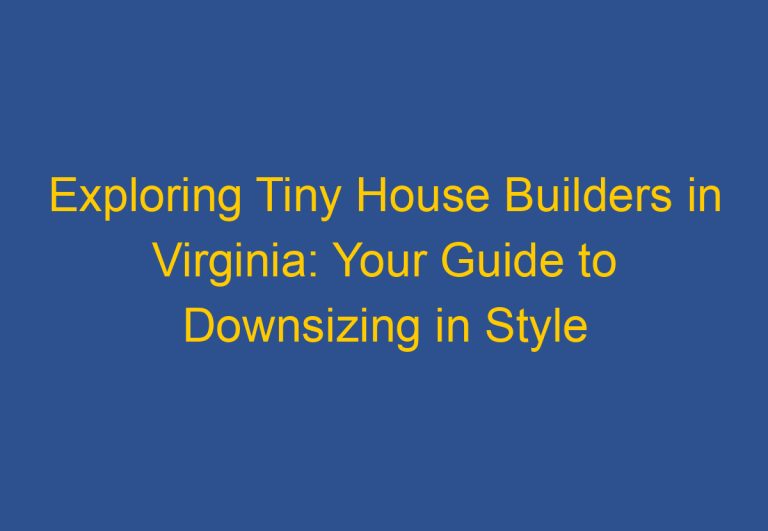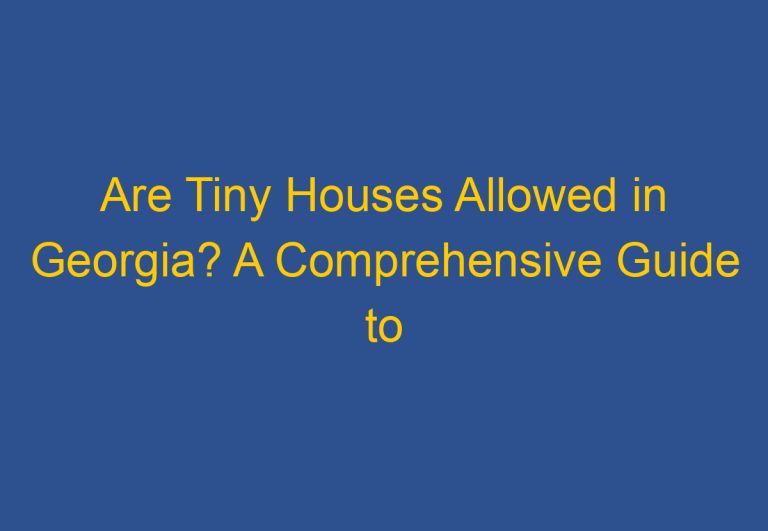Are Tiny Houses Illegal? Understanding the Legalities of Living in a Tiny Home
Tiny houses have become increasingly popular in recent years, with many people opting for a simpler, more sustainable lifestyle. However, the legality of tiny houses is a topic of much debate. Are tiny houses illegal? The answer is not straightforward and varies depending on a number of factors.
One of the main reasons why tiny houses may be illegal is due to zoning regulations. Many cities and counties have specific rules regarding the size and type of homes that can be built in certain areas. In some cases, tiny houses may not meet these requirements and could be deemed illegal. Additionally, safety regulations must be followed when building a tiny house, which can also impact its legality.
Despite these challenges, the tiny house movement continues to gain momentum. Advocates argue that tiny houses offer a more sustainable and affordable alternative to traditional homes. While the legality of tiny houses may be a concern, many people are still drawn to the idea of living a simpler, more minimalist lifestyle.
Legality and Zoning Regulations
When it comes to tiny houses, legality and zoning regulations can be a complex and confusing topic. In this section, we will explore the various aspects of zoning laws, building codes, and state-specific regulations that are relevant to tiny houses.
Understanding Zoning Laws
Zoning laws are regulations that govern the use of land in municipalities. These laws dictate how land can be used, what types of structures can be built, and where they can be located. Zoning laws are typically created and enforced by local governments, such as cities or counties.
For tiny house owners, zoning laws can be a major obstacle. Many municipalities do not allow tiny houses to be parked or lived in on residential property. Others require tiny houses to be located in designated areas, such as campgrounds or RV parks.
Building Codes and Tiny Houses
Building codes are regulations that dictate how buildings must be constructed in order to ensure safety and compliance with local laws. These codes cover everything from the materials used in construction to the size and placement of windows and doors.
For tiny houses, building codes can be a challenge. Many tiny houses are built on trailers, which can make compliance with building codes difficult. Additionally, some municipalities have specific building codes for tiny houses that must be followed in order to be considered legal.
State-Specific Regulations
State-specific regulations can also impact the legality of tiny houses. While some states have embraced the tiny house movement and have created laws specifically to accommodate them, others have not.
For example, California has some of the most progressive laws regarding tiny houses, allowing them to be built as ADUs (Accessory Dwelling Units) on residential properties. On the other hand, states like Florida and Oregon have limited regulations, making it difficult for tiny house owners to find legal places to park and live in their homes.
In conclusion, navigating the legal landscape of tiny houses can be complex and challenging. Understanding local zoning laws, complying with building codes, and researching state-specific regulations are all crucial steps to ensure that your tiny house is legal and compliant with all applicable laws and regulations.
Design and Lifestyle Considerations
When considering the design and lifestyle of a tiny house, there are several factors to keep in mind that can impact its legality. This section will explore some of the most important considerations, including space efficiency and requirements, mobility and foundation options, and utilities and off-the-grid living.
Space Efficiency and Requirements
One of the biggest challenges when designing a tiny house is making the most of the limited space available. To be considered a tiny house, a dwelling must have no more than 400 square feet of living space and can be as small as 60 square feet. This means that every inch of space must be used efficiently, with careful consideration given to the placement of furniture, appliances, and storage solutions.
Mobility and Foundation Options
Another important consideration is whether the tiny house will be mobile or stationary. Tiny houses on wheels (THOWs) are a popular option for those who want the flexibility to move their home from place to place. However, they are subject to strict building codes and zoning laws, and may not be allowed in certain areas. Alternatively, a tiny house on a permanent foundation may be subject to safety regulations and zoning laws that differ from those for recreational vehicles (RVs) or mobile homes.
Utilities and Off-the-Grid Living
Finally, when designing a tiny house, it is important to consider the utilities and amenities that will be needed. This includes water, electricity, plumbing, and ventilation, as well as a source of heat and energy. For those who want to live off the grid, it may be necessary to install solar panels or other alternative energy sources, and to rely on rainwater collection or other methods for obtaining water. Additionally, it is important to consider permits and local government regulations when setting up hookups for utilities.
Overall, designing a tiny house requires careful consideration of a wide range of factors, from the size and layout of the space to the amenities and utilities that will be needed. By understanding the regulations and requirements that apply to tiny houses, and by designing a space that meets these requirements while also meeting the needs and preferences of the homeowner, it is possible to create a safe, comfortable, and legal tiny home that offers a simpler, more sustainable way of life.
Frequently Asked Questions
What zoning regulations affect tiny house construction and placement?
Zoning regulations can vary by state, county, and city, but they can have a significant impact on the construction and placement of tiny houses. Some areas may require a minimum square footage for a dwelling to be considered legal, while others may have restrictions on where a tiny house can be placed on a property. It is important to research and understand the zoning regulations in your area before building or placing a tiny house.
How do building codes impact tiny house legality?
Building codes can also have an impact on the legality of tiny houses. In order for a tiny house to be considered legal, it must meet certain safety standards and requirements, such as those set by the International Code Council. Building codes can also vary by state, county, and city, so it is important to research and understand the building codes in your area before building a tiny house.
In which states are tiny houses on wheels considered legal residences?
The legality of tiny houses on wheels can vary by state. Some states, such as California, Oregon, and Texas, have specific laws that allow for tiny houses on wheels to be considered legal residences. Other states may not have specific laws regarding tiny houses on wheels, but they may still be considered legal residences if they meet certain requirements.
What are the minimum size requirements for a dwelling to be legal?
Minimum size requirements for a legal dwelling can vary by state, county, and city. Some areas may require a minimum square footage for a dwelling to be considered legal, while others may not have specific size requirements. It is important to research and understand the minimum size requirements in your area before building or placing a tiny house.
Can you legally live in a tiny house on your own land?
Whether or not you can legally live in a tiny house on your own land can depend on a variety of factors, including zoning regulations, building codes, and minimum size requirements. It is important to research and understand the laws and regulations in your area before living in a tiny house on your own land.
What permits are needed to build a tiny house in urban areas?
The permits needed to build a tiny house in urban areas can vary by state, county, and city. Some areas may require building permits, while others may require additional permits for things such as plumbing and electrical work. It is important to research and understand the permit requirements in your area before building a tiny house in an urban area.










